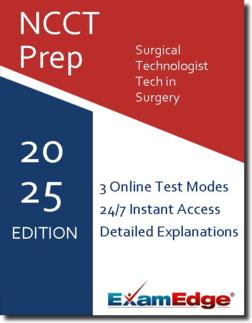NCCT Surgical Technologist - Tech in Surgery (TS-C) Practice Tests & Test Prep by Exam Edge - Topics
Based on 20 Reviews
- Real Exam Simulation: Timed questions and matching content build comfort for your NCCT Surgical Technologist - Tech in Surgery test day.
- Instant, 24/7 Access: Web-based NCCT Surgical Technologist practice exams with no software needed.
- Clear Explanations: Step-by-step answers and explanations for your NCCT exam to strengthen understanding.
- Boosted Confidence: Reduces anxiety and improves test-taking skills to ace your NCCT Surgical Technologist (TS-C).

Understanding the exact breakdown of the NCCT Surgical Technologist test will help you know what to expect and how to most effectively prepare. The NCCT Surgical Technologist has 170 multiple-choice questions The exam will be broken down into the sections below:
| NCCT Surgical Technologist Exam Blueprint | ||
|---|---|---|
| Domain Name | ||
| Surgical Care | ||
| Pre-Surgical Care and Preparation | ||
| Intra Operative Care | ||
| Post-Operative Care | ||
| Additional Duties | ||
| Administrative and Personnel | ||
| Equipment Sterilization and Maintenance | ||


